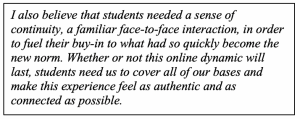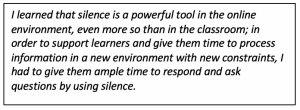In March 2020, the University of Toronto moved to an entirely online/remote teaching environment in response to the global COVID-19 pandemic. Instructors, staff and students pivoted quickly and, for some, there was a steep learning curve. This Re:Think series focuses on instructor experiences – how they connected with students and colleagues, the creative ways they approached the transition, and the challenges they faced and resources they discovered while doing so.
We asked graduate student peer trainers with the Teaching Assistants’ Training Program to share their experiences as teaching assistants, Course Instructors and TATP staff members during this time.
Nicole Birch-Bayley
Humanities Trainer, Teaching Assistants’ Training Program
PhD Candidate and Teaching Assistant, Department of English
Connecting Through Learner Buy-in
Full disclosure: I have worked in an online educational context before. So, while the recent shift to online teaching and learning has presented all of us with new challenges, myself included, I have some background navigating the strange world of Zoom rooms, Slack channels, and Google Docs.
For the last two years, I have worked as a Teaching Assistant for ENG140 Literature for Our Time at the St. George campus; working on a team of 10 other TAs, I run two of my own discussion-based tutorials with 20 students each.
Many of my first-year students had not imagined themselves taking online courses so early on in their postsecondary degrees; a number of them lived in residence before the pandemic forced them to relocate back to their family homes, or even temporarily to a friend’s guest room or pullout couch. Several of my students expressed concern about the uncertainty of their futures. How long would this online dynamic last? Would they be able to make friends and foster meaningful relationships with professors and TAs in an online course?
To my surprise, despite these feelings of uncertainty, my group of undergraduate students demonstrated a powerful sense of buy-in to their new online learning context.
Before the pandemic, several of my students would often ask me for extra office hours. In their first year, they needed a lot of support in the transition from high school or from previous careers; they wanted one-on-one meetings to talk through their concerns and hear their experiences normalized.
When I was instructed to suddenly wrap up my in-person tutorials and office hours, my students were left wondering what the remainder of the course would look like. The professor of this course decided to make any future online tutorials optional, which made sense at the time, given that many of our students found themselves on flights back to Dubai and other international destinations, or without a reliable internet connection or access to Quercus.
Yet, when I indicated that I would be willing to connect with my students online or even by telephone if necessary, they demonstrated buy-in and readiness to adapt to their new learning context by asking for more office hours and optional tutorials to cover the material left out of the final in-person lecture. They wanted our discussion-based tutorials to continue so that they could process the new readings and talk through difficult concepts; they also needed something close enough to face-to-face writing support in order to help them navigate their final assignment, a replacement of the final exam.
 Encouraging Student Engagement
Encouraging Student Engagement
As someone who loves to experiment with educational technology, I have also been pleasantly surprised to see how my students have quickly capitalized on the different tech features available to them in the online environment. In only a matter of weeks, I noticed the benefits.
During my online tutorials, with about 15-20 students who were able to attend, I used the breakout room feature. I have been able to join each breakout room and observe small group discussions, just as I would wander around the classroom to participate in conversations and help clarify certain points. Although we cannot survey an entire online classroom of breakout rooms and determine whether every group is staying on track, as we might on campus, I have noticed that students remain actively engaged in these group sessions.
The chat feature (available in Bb Collaborate or MS Teams) has been a game changer. By encouraging learners to share their questions and comments in the chat panel throughout a live discussion, I have witnessed some of my quietest students contribute their insights in lively and unexpected ways. In this sense, the chat feature can actually make online classes more inclusive and equitable than an in-person discussion – that is, as long as the facilitator allocates time throughout the class to address written questions and comments as they arise.
Finding Creative Ways to Visualize Teaching and Learning in the Online Environment
Teaching without face-to-face contact can be very tricky.
In my other role as a Trainer for the Teaching Assistants’ Training Program, I recently co-facilitated a Course Instructor (CI) Training Camp on Bb Collaborate. To avoid issues for students with a less robust internet connection, my colleagues and I opted to run our two-part synchronous webinar, which brought together 50+ new Course Instructors, with all video cameras turned off.
This faceless dynamic felt very strange at first. I needed to deliver new content to learners while at the same time suddenly limited by how much I could see and hear from the participants.
Running live webinars also requires a lot of visual and verbal multitasking. During the CI Training Camp, I was grateful to have two other TATP staff members moderate the chat panel, helping to answer questions as they emerged and organize participants into breakout rooms when needed. But it was still challenging to gauge learner understanding without the ability to see whether or not they were actively listening.
Also, in a subsequent webinar, TATP staff distributed a link to a SharePoint Word document in order to encourage learners to contribute their ideas and follow along with the group discussion. Using a shared document, the staff were able to see in real-time whether learners were actively engaged, without the need for multiple moderators to assist in a continuous Q&A that might lead the discussion too off-course.
 Adapting Without Reinventing the Wheel
Adapting Without Reinventing the Wheel
While there are certainly new challenges for TAs and Course Instructors, especially those facilitating larger lectures, labs, and courses with very different learning outcomes, I don’t think we need to overhaul everything from our teaching toolkits in order to work well in the online environment. In a humanities course, my role as a TA involves discussing readings with the students, ensuring that they have access to course content through lectures and other resources, and assessing their written assignments by providing qualitative and quantitative feedback.
Office hours have been and will continue to be an essential element of how I support my students in the online environment. Meeting online instead of meeting students at the St. George Campus has not been a huge adjustment, since I simply post the meeting url at the top of each new signup sheet rather than listing a room number and building location.
In the future, I also plan to ask my students whether they prefer video meetings or audio discussions, most likely using a Community Agreement at the start of the new term. While I prefer teaching online using live video classes, I have realized after hosting several webinars that mandatory video participation introduces new accessibility and equity concerns, as some students will have limited internet access or be hesitant to appear on video in the privacy of their homes, among other considerations.
I have also noticed certain assumptions made about the current generation of undergraduate students – that they are “naturally good” at using technology as “digital natives.” From my experience working with a diverse group of learners in undergraduate courses, it is safer to assume that all students will need some measure of guidance on user netiquette and support when adjusting to new EdTech tools, just as a TA or CI would need to explain the expectations, learning outcomes, and formatting of any given assignment.
Whether in the classroom or in the online environment, I try to gauge my students’ concerns using multiple forms: an “Access Check” at the start of the first class (which is also a staple of TATP programming), student questionnaires distributed periodically throughout the course, a drop-in Q&A discussion board, and any other available avenues to ensure that my students’ voices are heard.
While this (COVID-19) situation is unprecedented, I have tried to support my students by inviting them to share their fears and concerns, by normalizing these open conversations, and even by sharing in my own challenges as a teacher and learner. While I am not suggesting that TAs or CIs provide an unsolicited biography or communicate a narrative about resilience that risks diminishing students’ unique challenges, I feel that sharing some insight about my own transition has helped my students trust in me, as we navigate this situation together as learners.























